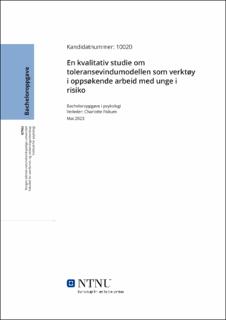| dc.contributor.advisor | Fiskum, Charlotte | |
| dc.contributor.author | Nguyen, Vivi | |
| dc.date.accessioned | 2023-07-04T17:20:12Z | |
| dc.date.available | 2023-07-04T17:20:12Z | |
| dc.date.issued | 2023 | |
| dc.identifier | no.ntnu:inspera:146342237:96609603 | |
| dc.identifier.uri | https://hdl.handle.net/11250/3075796 | |
| dc.description.abstract | Denne kvalitative studien hadde som formål å undersøke på hvilke måter toleransevindumodellen kan være nyttig i oppsøkende arbeid med unge i risiko. Dette ble undersøkt gjennom problemstillingen: «Kan toleransevindumodellen brukes som nyttig verktøy i oppsøkende arbeid med unge i risiko, og isåfall på hvilke måter?» Som inngåelse i forskningsprosjektet «Regulering i oppsøkende arbeid» ledet av Charlotte Fiskum, ble det gjennomført 11 semistrukturerte intervjuer og utført tematisk analyse av datamaterialet. Resultatet av analysen ble to hovedtemaer ved navn Bevisstgjøring og Regulerende aktiviteter. Disse ble sett i lys av teori om toleransevindumodellen. Resultatene viste at modellen virket nyttig som forståelsesramme i det oppsøkende arbeidet, og avdekket en rekke aktiviteter som brukes i det oppsøkende arbeidet som kan virke regulerende i tråd med toleransevindumodellen. Dette bidrar til kunnskap om hvordan man kan jobbe reguleringsstøttende i oppsøkende tjenester, og for å tilrettelegge og styrke oppsøkernes ressurser til å kunne utføre en god jobb med utsatte ungdommer. | |
| dc.description.abstract | The aim of this qualitative study was to investigate in which ways the window of tolerance model can be useful in outreach social work with at-risk-youth. This was investigated through the research question: “Can the window of tolerance model be used as a useful tool in outreach social work with at-risk-youth, and if so in what ways?” As part of the research project “Regulation in outreach social work” led by Charlotte Fiskum, 11 semi-structured interviews were conducted and a thematic analysis of the data was carried out. The results of the analysis were two main themes named Awareness and Regulating activities. These were seen in relation to theory of the window of tolerance. The results showed that the model was useful as a framework of understanding in the outreach social work, and revealed several activities that were used in outreach social work that could be regulating in line with the window of tolerance model. This contributes to knowledge about how one can work supportive with regulation in outreach social work, and facilitate and strengthen outreach social workers’ resources to be able to do a good job with vulnerable young people. | |
| dc.language | nob | |
| dc.publisher | NTNU | |
| dc.title | En kvalitativ studie om toleransevindumodellen som verktøy i oppsøkende arbeid med unge i risiko | |
| dc.type | Bachelor thesis | |
